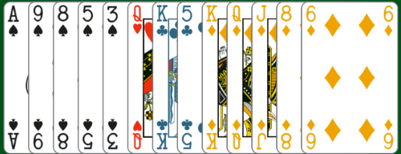
When to play in a 4-3 fit in Major? – by Milan Macura
Only 13 players left to reach 2,000 players in the tournaments: 825 played the MP one and 1,162 the IMP one.

MPs results
We have been dealt very interesting boards in the MP tournament. If you played focused, you could score over 80% in every single board. The most focused was Ulf (SE) who won with 83.01% followed by Steven (BE) and Martine (FR) with 79.79%.
I managed to get to the main screen with 74.99% and took the silver on my friends’ list. Marc (UK) and Kuba (CZ) also managed to score over 74%. Congratulations to all!


IMPs results
The IMP tournament was completly different. I scored small plus only in 3 boards and finished with -13 IMPs. Boards 2, 3 and 8 in particular, where you had to reach the right game and make it, determined who got to the top. The other boards made only small differences and Leonhart (CH) was the best and won the tournament with +33 IMPs, followed by Martine (FR) and Losing Nemo (UK) with +32 IMPs. Other players were behind by only one or two overtricks.
My friends seemed to have a similar judgement as mine. Godull (FA) with +24 IMPs, Giorgio (IT) and Attilga (IT) with +23 IMPs hit 2 out of the 3 boards right.


When to play in a 4-3 fit in Major?
The overall strategy in bridge is to find a major fit, at least 8 cards, and determine if you have enough values to make a game or a slam. If you don’t find any, you tend to go NT and only if you are short in one of the suits and have a good minor fit, you try the minor game.
In some cases, especially in MP, you can get the best score by playing a trump game without a fit. There are very rare cases where even a slam on a 4-3 fit is better than 6NT or playing on a 5-3 fit.
How to find out it is a special case?
- You have a shortness in a suit where you have 3-card trumps – usually 5431 or 6331 distributions.
- You have a minor side suit which can produce quick tricks.
- The 4-card trumps are good enough to win at least 3 rounds.
The general idea is to have a control in the short suit by trumping the second or third round where you can lose 4-5 tricks in NT. The next step is to draw trumps and cash your long side suit. The extra ruff on the short side provides the extra trick which you cannot get if you trump with your 5 or 6-card suit.
Here is an example from the MP tournament. You get the following hand.
How do you plan the bidding?


After two passes, you open 1♣ and the RHO overcalls 2♥ over your partner’s 1♠ response. Obviously, you might have issues in hearts in a NT contract. The best option is to double and give partner a chance to choose the best contract.
Most people play the double in this position as support double. That makes it difficult to find out if your partner has 5-card spades or only 4-card with no better bid when he rebids 2♠. My setup with Argine is support double, but indicating a semi-balanced hand. It means that I pass with a balanced 12-14 HCP hand and a 3-card fit.
With my human partner, we play support double only if we bid hearts and opponents overcall in spades. Because if they overcall in the other minor, finding the fit in the other major is often more difficult than to find the 5-3 fit in the suit partner already bid.
On this particular board, I chose to bid 3♥ after 2♠ to indicate extra strength and when partner supported me in 4♣, I gave her an option to play 4♠. Partner chose the 5♣ contract.
Here is the full deal:

Let’s have a look at the checklist mentioned above:
- You have a shortness on the side with 3 trumps.
- You have good side suits to produce quick tricks.
- You don’t have good 4-card trumps – but the layout is very favorable so you can draw all the trumps.
This board is quite lucky because of the spade and heart distribution.
In 3NT, defenders can cash only 3 tricks. If they lead the ♥A/K and see the dummy, they can switch to spades to get partner to the trick. But when West plays a heart, North can put the ♥9 and produce a heart stopper.
In 4♠, East can also play only one round of hearts. If he plays the second top heart, you can trump in South, cross to North hand and finesse the ♠Q which drops into the ♠K in the second round. North has enough entries to draw the rest of the trumps and the ♥J stops opponents in cashing heart tricks. So 4♠ can make 11 tricks and a top score.
5♣ can be made only if East holds the ♠Q. Still, it gives you an above-average score.

The next board comes from the last challenge; the opponent was Ine (NL).

You have 17 HCP and a flat hand. Everybody will probably open 1NT. Once you respond 2♠ to a Stayman, partner jumps to 4♦ to show shortness and a spade fit. But he is a passed hand.
What do you do?

My personal guess is that most of the players will bid the same as Ine, i.e. 4♠. The hand is 4333, partner is a passed hand and you have AK opposite a singleton so the slam seems impossible.
My thinking is a bit different. I wondered: “With which hand partner bids Stayman and invites me to slam, without being strong enough for the opening?”. He must be 54 or 64 in Majors and have 6 losers. That’s an aggressive slam try opposite a 1NT opening because the maximum number of useful honors for 1NT is 5.
Now, do you have a good hand? YES. All your honors are useful and you have quick tricks in minors so you can discard the losers before losing a spade or heart trick. Having all the information necessary, I jumped to 6♠ directly.
Here is the full board:

With the actual layout, you can make 13 tricks very easily. But if you reach 6♠, you should play safe and either start with the ♠5 towards the ♠Q or cross to dummy and play the ♠2 with the intention of putting the ♠10 if East follows with the ♠7. That way, you will lose only one spade trick if they split 3-0 either side.
Videos of Milan Macura’s tournaments
MPs tournament video
Subscribe to be notified directly when my next video is online! Click on the button below:
IMPs tournament video
You can find all the boards of the IMPs tournaments in the video I posted on my YouTube channel. Don’t forget to Subscribe to so you don’t miss my next Exclusive tournaments analysis.
And if you didn’t know it yet, know that I challenge 5 of you at the end of each IMP tournament video!
My previous exclusive tournaments analysis are available here.



